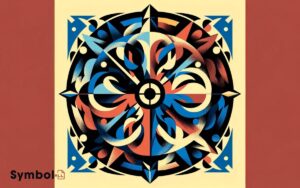What Does the Color Yellow Symbolize in the Bible? A Guide!
In the Bible, you’ll find yellow symbolizes divine glory, wisdom, and purity, painting a rich tapestry of human and divine interaction. It’s a color that embodies God’s omnipresence, offering guidance and enlightenment, signifying a bridge between the earthly and the divine.
Beyond its representation of sanctification and spiritual renewal, yellow also brings forth images of healing, hope, and joy. It underscores moments of divine comfort and celebration, marking instances of spiritual rejuvenation and communal joy.
Yet, it doesn’t shy away from depicting greed, deceit, and moral decay, cautioning against spiritual downfall.
This duality makes yellow a profound symbol in biblical texts, inviting further exploration to uncover its deeper meanings.

Key Takeaway
Divine Glory and Presence
In exploring the symbolism of yellow in the Bible, it’s pivotal to note that this color often signifies divine glory and presence, reflecting a profound connection between the divine and the earthly.
This hue, bright and vibrant, isn’t merely a visual element; it embodies the ethereal and the transcendent.
When you investigate biblical texts, you’ll find that yellow, especially in the context of gold and its radiance, represents not just wealth or power, but a manifestation of God’s splendor.
It’s a visual metaphor for how the divine light breaks into the human domain, offering guidance, wisdom, and enlightenment.
This association encourages you to perceive the divine in the midst of the mundane, inviting a deeper reflection on the omnipresence and omnipotence of the divine in your life.
Purity and Purification
As you explore the theme of purity and purification within the biblical context, it’s essential to understand how yellow, as a color, signifies symbolic cleansing acts.
This hue not only embodies divine purity representation but also invites a deeper reflection on the processes and rituals of sanctification mentioned throughout the scriptures.
Symbolic Cleansing Acts
Symbolic cleansing acts within the Bible frequently signify purity and purification, embodying the transformative power of spiritual renewal.
These acts, ranging from the washing of feet to the sprinkling of sacrificial blood, aren’t merely ritualistic performances.
Instead, they’re deeply embedded with theological significance, denoting a shift from a state of impurity to one of holiness.
You’ll find that these rituals serve as metaphors for the internal cleansing of the soul, highlighting the Bible’s emphasis on spiritual integrity over mere outward conformity.
Such practices underscore the belief that true purification stems from a profound internal process facilitated by divine intervention, rather than through human efforts alone.
This perspective encourages a reflective approach to understanding purity, urging you to look beyond the physical acts to grasp their spiritual essence.
Divine Purity Representation
The concept of divine purity in the Bible represents an ultimate standard, challenging believers to mirror this sanctity in their personal spiritual journey.
This purity isn’t merely about ceremonial cleanliness or moral perfection; it encompasses a holistic sanctification, set apart for divine purposes.
When considering the symbolism of yellow, often associated with gold, it signifies not just wealth or royalty but a divine purity that’s untainted and glorious.
This color, when mentioned in a biblical context, prompts you to reflect on the divine’s pure light, illuminating the path to spiritual purification.
It’s a reminder that this journey isn’t about reaching a state of sinlessness on one’s own but embracing the process of being refined and purified in the light of divine truth.
Healing and Hope
You’ll find that yellow’s representation extends into areas of healing and hope within biblical texts, symbolizing divine comfort and the renewal of faith. This hue serves as a beacon, guiding the faithful through trials towards spiritual rejuvenation.
It’s in these narratives that you observe how yellow not only cleanses but also imbues individuals with a renewed sense of purpose and optimism.
Divine Comfort
In biblical narratives, yellow often serves as a beacon of divine comfort, offering healing and hope to those enduring hardship.
This color’s presence in scripture isn’t merely ornamental but deeply symbolic, embodying God’s promise of restoration and peace.
When you encounter yellow in the Bible, it’s as if you’re witnessing the divine hand at work, soothing pains, mending broken spirits, and illuminating paths with its gentle radiance.
This hue doesn’t just represent the presence of divine comfort; it acts as a vessel through which God’s grace flows into the lives of believers.
Its symbolism extends beyond the spiritual sphere, touching the celestial, where it fosters an environment ripe for healing.
Yellow, hence, isn’t just a color it’s a divine intervention, a visual manifestation of God’s unwavering commitment to heal and uplift.
Renewed Faith
Yellow’s symbolism in the Bible extends to embodying renewed faith, offering both healing and hope as it rekindles the spirit of believers facing adversity.
This vibrant hue, often associated with sunlight and dawn, metaphorically represents the divine promise of a new beginning after periods of darkness.
By analyzing biblical narratives, you’ll discover that yellow’s presence subtly underscores moments where characters experience a profound transformation or healing, leading to a strengthened faith.
It’s not merely about physical rejuvenation but also a spiritual awakening that instills a resilient hope in God’s faithfulness.
This insightful interpretation encourages you to view yellow not just as a color, but as a symbol of God’s ability to renew and uplift the weary soul, making it a powerful emblem of spiritual resurgence.
Joy and Celebration
Throughout the Bible, yellow often embodies joy and celebration, signaling moments of divine favor and profound communal happiness.
This vibrant color serves as a beacon of optimism, reflecting the light and goodness associated with joyful occasions.
- Yellow, as seen in garments and decorations, marks celebrations and holy days, illustrating the community’s shared elation.
- It signifies the presence of God’s glory, enveloping believers in warmth and divine love during times of rejoicing.
- In parables and visions, yellow hues highlight moments of revelation and joyous insight.
- Festive gatherings often feature yellow, symbolizing unity and shared joy among the faithful.
- This color’s association with harvests speaks to the joy of reaping spiritual and physical blessings.
Analyzing yellow’s use in biblical contexts reveals its deep connection to themes of joy, celebration, and divine presence, enriching our understanding of scriptural messages.
Wisdom and Knowledge
As you explore the symbolism of yellow in biblical contexts, it’s essential to recognize that wisdom and knowledge aren’t merely human achievements but are depicted as divine gifts.
The scripture positions wisdom’s divine source as central, suggesting that true understanding is a manifestation of the divine within the mundane.
In seeking wisdom faithfully, one is engaging in a holy pursuit, underscoring the belief that knowledge isn’t just acquired but bestowed upon those who seek with a righteous heart.
Wisdoms Divine Source
Exploring the symbolism of yellow in the Bible, it’s crucial to acknowledge that wisdom and knowledge often originate from a divine source.
This connection is deep and multifaceted, reflecting a profound understanding that transcends mere human intellect.
- Divine Inspiration: Wisdom in the Bible is depicted as a gift from God, illuminating the minds of those who seek it.
- Moral Guidance: It serves as a compass, guiding individuals toward righteousness.
- Understanding Beyond Age: Biblical wisdom demonstrates that insight doesn’t solely depend on one’s years but on their openness to divine truth.
- Prophetic Insight: It includes the ability to interpret divine messages and visions.
- Foundation for Leadership: Many biblical leaders were chosen based on their wisdom, which was seen as evidence of divine favor.
This perspective on wisdom underscores its sacred origin and purpose.
Knowledge: A Holy Gift
Building on the understanding that wisdom has its roots in the divine, it’s equally important to recognize knowledge as a sacred gift bestowed upon humanity.
This acknowledgment is vital in comprehending how biblical texts view the acquisition and application of knowledge.
Unlike secular perspectives that may regard knowledge as merely a tool for personal or societal advancement, the Bible positions it within a spiritual framework.
It emphasizes that true knowledge isn’t just about gathering information but involves a profound understanding and reverence for the divine will.
This perspective encourages you to see knowledge not as an end in itself but as a means to deepen your relationship with the divine, fostering a life that reflects divine principles and values.
Seeking Wisdom Faithfully
Setting out on the journey for wisdom requires a resolute heart and a steadfast dedication to the divine path outlined in biblical teachings.
This pursuit isn’t merely an intellectual endeavor but a holistic engagement with the sacred texts and principles that guide moral and spiritual life.
- Pray for insight and understanding regularly.
- Study the scriptures diligently, seeking the deeper meanings behind the texts.
- Embrace humility, acknowledging that true wisdom comes from God.
- Apply the teachings to everyday life, allowing them to shape your actions and decisions.
- Reflect on your experiences and the lessons learned, fostering a continuous cycle of learning and growth.
In this analytical exploration, remember that seeking wisdom faithfully is an ongoing process, enriched by patience, devotion, and a sincere yearning to draw closer to the divine.
Wealth and Prosperity
Throughout the Bible, yellow often symbolizes wealth and prosperity, serving as a vivid indicator of divine favor and earthly riches.
This color’s association with gold, a material frequently mentioned in scriptures, underscores its significance.
In ancient times, gold represented not only material wealth but also the spiritual blessings bestowed upon those who follow God’s commandments.
When you encounter yellow in biblical texts, it invites you to reflect on the broader implications of wealth in a spiritual context. It suggests that prosperity isn’t solely about accumulating wealth but also about embracing the abundance God provides.
This perspective encourages you to appreciate the blessings in your life, recognizing them as manifestations of divine grace rather than mere material possessions.
Greed and Deceit
While yellow often heralds prosperity and divine favor, it also harbors a darker symbolism in the Bible, representing greed and deceit that can ensnare the soul.
This dual nature prompts a deeper reflection on how material wealth, symbolized by yellow, may lead to spiritual downfall if not approached with humility and wisdom.
- Yellow’s brightness can blind one to moral imperatives.
- Wealth, while not inherently evil, becomes a test of character.
- Deceit, often tied to the pursuit of wealth, separates individuals from spiritual truth.
- The pursuit of material gain can lead to a neglect of spiritual needs.
- Greed disrupts community harmony and fosters isolation.
Analyzing this aspect of yellow’s symbolism encourages a balanced perspective on wealth, warning against letting material desires overshadow spiritual growth and ethical conduct.
Cowardice and Fear
Moving beyond the domains of greed and deceit, yellow’s symbolism in the Bible also encompasses the notions of cowardice and fear. It invites us to examine how these traits can spiritually hinder individuals.
This color’s association with cowardice isn’t merely about the lack of courage in the face of adversity. It’s a deeper reflection on the spiritual paralysis that fear induces.
Fear, as symbolized by yellow, often leads to inaction or the wrong action, distancing individuals from their moral and spiritual paths. It serves as a warning against allowing fear to dictate one’s decisions, urging believers to find strength in faith.
By understanding this symbolism, you’re encouraged to confront and overcome the fears that challenge your spiritual growth, fostering a journey towards resilience and courage.
Disease and Decay
In the biblical narrative, yellow often serves as a stark symbol of disease and decay, reflecting the physical and spiritual corruption that can beset human life.
This color’s association with illness and decline isn’t merely superficial; it’s deeply embedded in the stories and teachings, offering a vivid depiction of life’s fragility.
- Yellow’s depiction of leprosy highlights the physical manifestation of sin.
- It signifies the impermanence and vulnerability of human existence.
- Yellow garments in scripture often underscore a character’s moral decay.
- The color warns of the consequences of straying from the divine path.
- It serves as a reminder of the purification process necessary for spiritual renewal.
These elements collectively underscore yellow’s complex symbolism, inviting a contemplative approach to its biblical appearances.
Light and Enlightenment
Yellow’s symbolism in the Bible, however, extends beyond its ominous associations with disease and decay, illuminating aspects of light and enlightenment that reveal the divine intention for spiritual awakening and wisdom.
This color, often seen as the hue of dawn, represents the presence of God’s light in the darkness of the human condition, offering a path to deeper understanding and truth.
You’ll find that, in scripture, yellow as light signifies God’s guidance, illuminating the way for the faithful and leading them towards enlightenment.
This metaphorical use emphasizes the pursuit of knowledge and the illumination of the mind and soul. It’s a call to embrace divine wisdom, to seek clarity in one’s spiritual journey, and to find solace in the light of God’s presence amidst the shadows of worldly struggles.
Covenant and Promise
Beyond illuminating the path toward enlightenment, yellow in the Bible also embodies the sacred themes of covenant and promise, signifying God’s unwavering commitment to His people.
This vibrant hue serves as a powerful symbol, reflecting the depth and permanence of the divine assurances given throughout the scriptures.
Here’s what makes yellow so significant in this particular situation:
- It represents the durability of God’s word.
- Symbolizes the gold and preciousness of these divine promises.
- Evokes the warmth and reliability of God’s love.
- Stands as a beacon of hope during trials.
- Highlights the eternal nature of God’s agreements with humanity.
Analyzing yellow’s usage in biblical texts reveals its intricate role in depicting the solemn agreements between the divine and mankind, underscoring the profoundness of these spiritual bonds.
Transition and Change
Yellow, as a symbol of metamorphosis and change in the Bible, captures the dynamic nature of spiritual evolution and the unfolding of divine plans.
When you explore the scriptures, you’ll find that yellow often marks periods of transformation, signaling not just an end but a promising new beginning.
This hue serves as a divine highlight, underlining moments of profound change. It’s as if the color itself is a visual cue, whispering of the growth and renewal that follows periods of trial and uncertainty.
Through this lens, yellow isn’t just a color; it’s a narrative device, elegantly illustrating the shift from one state of being to another. It encourages you to perceive change not as loss, but as the necessary path toward fulfillment and enlightenment.
Conclusion
To sum up, the color yellow in the Bible serves as a multifaceted symbol, shimmering like gold with layers of divine significance. It embodies divine glory, purity, and the hope of healing, while also celebrating joy and wisdom. To sum up, the color yellow in the Bible serves as a multifaceted symbol, shimmering like gold with layers of divine significance. It embodies divine glory, purity, and the hope of healing, while also celebrating joy and wisdom. In a similar manner, the color white symbolism in Bible frequently accompanies themes of holiness, righteousness, and divine presence. Together, yellow and white illuminate the scriptures with their profound spiritual undertones, reflecting the splendor and sanctity of God’s eternal light.
Yet, it doesn’t shy away from representing disease and the inevitability of decay. This duality casts yellow as a beacon of enlightenment and a sign of covenant, guiding believers through changes and embodying the promise of change.
Truly, yellow weaves a complex tapestry of biblical symbolism, inviting deep reflection and insight.






